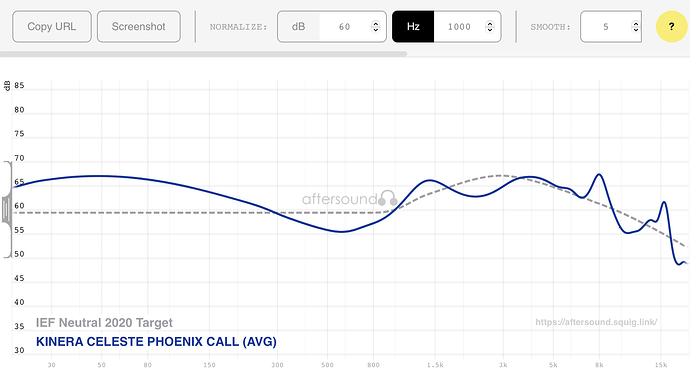Kinera Celest PhoenixCall or the Deceiving Reality of Agnostic Target Practice
I’m just going to cut to the chase: Ignore the graphs on PhoenixCall and give this a chance, if you’re in search of a sub-$200 IEM option. Why do I say this so emphatically? Well let’s get into it.
Songs to Listen to and Follow Along:
As usual, I’m going to write my thoughts in generalities, but I’ll give you a sample of songs that I listen to, that will relate to the concepts I write about. Feel free to ask for specifics, if you don’t keep up with my thought processes.
Playlist
Swashers/Bubbles - Yosi Horikawa (For imaging/detail retrieval (:00-1:00 Swashers), general technicalities check (both), soundstage depth/dynamics/layering/separation (:00-:30 Bubbles))
The Speedwalker (Live at Madison Square Garden) - The Fearless Flyers (For bass elements, particularly sub-bass/mid-bass interplay, drum kits, soundstage/layering)
DISINTER MY HEART - TRAILS (For treble response and resolution, male vocals, midrange response)
When I Fall (Outta Love) - Kevin Olusola (For Imaging/detail retrieval :00-:07, tonality, timbre, male/female vocal interplay)
Fundamental Elements of Madness - Dax Johnson (For soundstage width 1:10-1:26, piano tonality)
Holding On (Rome In Silver Remix) - Dabin (For female vocals, tonality, mid-bass response within mix From 1:12-1:36)
1 Thing - Sophie Powers (For sibilance, harshness/shoutiness, high volume listening check 1:28-2:01
*Wire & Guns - KID DAD (For general tonality (warmth vs. brightness) and note weight :10-35, for high volume listening 1:34-2:08)
THE SOUND
You know I never thought I was a beauty queen, and I never felt like a part of the scene; But when I look at you and you look at me, I never want you to change a thing
Broken In All the Right Places - I Am Jen
(IEM Tuning Style: V-Shape)
Why would I look at this:
(Graph Courtesy of aftersound.squig.link, normalized to 1000Hz)
And not be absolutely repulsed by what I see? The first thing to know about PhoenixCall is that the “excessive” bass boost you see, is compensating for a smaller dynamic driver, as PC only has a 7mm DD in it. So while the graph says there’s too much bass, it’s absolutely not the case in practice. It is a tight bass response that you perceive a lot of speed in; it’s definitely a midbass emphasis, but I say with the litany of Harman-styled IEMs, this is a well received tuning departure for me. If not going for absolute bass quantity, this bass is a smashing success in this price range. Thumbs up for me.
The midrange is a bit of a mixed bag for me: I think the lower-midrange is just there. It may simply be that too many sets I’ve listened/gravitated to lately have been more forward presenting in the midrange but I just feel like (at best) PC has just enough in that department; I think this is more a result of the midbass bump, but the actual lower midrange is rather de-emphasized to my ear. What this presentation does, however, is leave space for the elevated upper-midrange to not kill me. This is not an “audiophile” tuning but it’s fun AF. I get forward vocals but no harshness. I give up a little bit in the midrange details but I get less fatigue (1 Thing is bright but not harsh or fatiguing, unlike when I listen to most of the Simgot lineup, or even a warm set like Juzear 41T). The treble tuning and SPD drivers seem to help with this: There is a LOT of treble clarity and resolution, without nearly the same kind of embellished “fake” clarity from a set like Sennheiser IE600. Which is a valuable set to bring up. PC is the cheap alternative to IE600 I would say had not been on the market. I think PC has better bass than IE600, straight up, IE600 has better lower-mids, and PC basically keeps up with IE600 (from memory) with a less distracting elevation in the deep treble.
So, Goober, if this set is so great in tuning and the sound profile, why isn’t this some $300+ killer? Well, dear reader, it’s because of the soundstage/technicalities. Straight up, this has Aful P5 poo-poo soundstage. Everything is narrow, between-the-ears, without much height and only a touch of depth. If you just want to listen to music that’s great, but if you have a discerning ear for soundstage, this isn’t it. The technicals of PC are pretty good actually: I think they image very well in the soundstage you get, layering and separation are very good, and they play with a rather good dynamic range for the price point. But the lower-midrange performance and subpar soundstage put a cap on the level this set can reach.
THE GOOD
- Very good technical set under $150
- Satisfying bass for the style/configuration picked
- Great treble that plays as well as much more expensive sets
- This is an absolutely GORGEOUS set
- Earpieces are worth buying as statement pieces
THE BAD
- Subpar soundstage
- Sound is cramped between the ears
- Lower-midrange is lacking
- Helps the sound be more engaging but is less “accurate”
WHO IS THIS SET FOR?
- People who want engagement in their music
- This set is just fun in a way a set like Simgot EM6L did not pop me
- Anybody who wants a showstopping IEM
- @lcg842 basically drooled when I showed her the pair
- Somebody who hasn’t popped their $100+ cherry
- If I was starting from scratch this is a big-time recommendation to me
WHO IS THIS SET NOT FOR?
- Mid-Heads
- This doesn’t have the midrange chops you need
- People who want a safer tuning/set
- There are options that aren’t as bold and adventurous and get the job done
WHAT DOES IT ALL MEAN?
To me, the PC is another example of being rewarded for not just judging a set off of a graph. Sets like Oriolus Szalayi or Tri i3 have completely off-the-wall graphs but are very well tuned IEMs for their configurations (i3 I have experience with, Szalayi I know by reputation). To put this another way, I think there are a lot of good choices in the sub-$200 range (6 of which that stand out are Tri Starsea, Sound Rhyme SR5, Juzear 41T, Celest PhoenixCall, Raptgo Bridge, and Simgot EM6L). In my opinion, three of these sets follow a more traditional “looks good on a graph” profile for their sound quality: EM6L, Tri Starsea, and Juzear 41T; and I think three of these sets take a more significant risk to be a bit different: PhoenixCall, Bridge, and SR5. The former three are easy recommendations in many ways, but (aside for the SR5 which I didn’t totally jive for, which kind of proves my point) I’m rather drawn to the risk takers. If I was starting from scratch, I very well may skip the three safer sets and go right for the PhoenixCall and the Bridge. Especially in direct A/B competition, the EM6L is a very good (and much more traditionally popular) IEM but the IEM I enjoyed more is PC. I wanted to hear it more, because I can find numerous sets that are like EM6L in some way or another. PhoenixCall simply is an unexpected treat that puts together a configuration I wouldn’t have thought of and executes it in a quite delicious way. So I absolutely sign off on PC if you’re looking in this price range for your next set and want to take a risk and be adventurous. And that’s going to be it for this review. Enjoy your days, and take care till next time!
Rank for Kinera Celest PhoenixCall: B
Rank With Personal Bias: B+
Recommendation Level: Highly Recommended (V-Shape)
Rank As a Food: Nutella-Stuffed Strawberries

